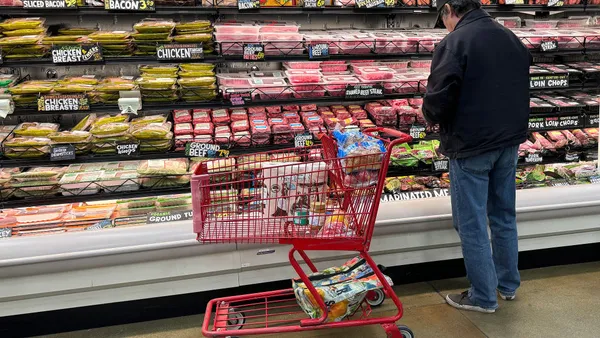Dive Brief:
- Seventy-three percent of households with incomes over $100,000 per year place a premium on low base prices when deciding where to buy groceries, according to research conducted in July by Dunnhumby — a level that is 7 percentage points higher than it was in April and underscores the widening impact inflation is having on the economy, the data analytics firm reported Monday.
- More than a third (37%) of grocery shoppers check prices online before and while they shop, while 35% shop around in search of the best value, findings from Dunnhumby’s latest Consumer Trends Tracker also show.
- Shoppers are stepping up their efforts to evade rising grocery prices as they perceive food-at-home inflation to be at an annual pace of nearly 23% — sharply above the actual rate of about 13% recorded by the federal government.
Dive Insight:
The latest figures from Dunnhumby underscore the close connection between people’s sense of where the economy stands and how they plot their grocery shopping strategy.
At the same time as people higher up the income scale gravitate toward retailers that emphasize lower prices, shoppers are showing growing interest in loyalty programs. More than half of shoppers in the July poll, which took into account responses from 2,000 U.S. consumers, said they consider a rewards program to be “very” or “extremely” important, up 3 percentage points from April, when Dunnhumby last collected responses from consumers for its Consumer Trends Tracker.
Accordingly, people have also become increasingly willing to identify themselves when shopping for groceries by logging in or providing a phone number when checking out, Dunnhumby found. The percentage of shoppers redeeming coupons or other deals that are part of a loyalty program has also ticked up.
Shoppers have also become more likely to buy larger sizes of products as they look to hold down costs, but Dunnhumby noted that purchasing larger quantities of goods to score lower units prices is less likely to be an option for people at lower incomes levels. In a reflection of this, Dunnhumby found that shoppers have also been steadily moving toward smaller package sizes to keep their tabs lower.
The survey also shows that people have become increasingly likely to trade down when deciding what to buy at the grocery store.
Consumers have been particularly willing to settle for lower-priced alternatives when shopping for packaged goods like pasta, cereal and canned vegetables; household products such as detergent and paper towels; and frozen foods. By contrast, shoppers have remained more likely to stay true to their established shopping patterns when selecting seafood, meat, fresh produce and prescription medicines, Dunnhumby found.
People’s sense that inflation is worse than it actually is has grown more pronounced as the year has progressed. In February, shoppers told Dunnhumby that they thought food prices were increasing at an annual rate of 17.7%.
In addition, the data from Dunnhumby indicates that inflation is contributing to rising food insecurity around the country. Thirty-one percent of households in the poll Dunnhumby conducted in July indicated that they have skipped or reduced the size of their meals over the past year, up 5% from April.










